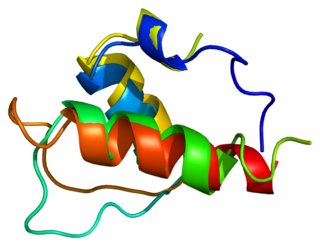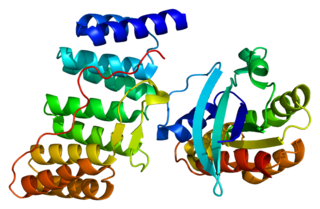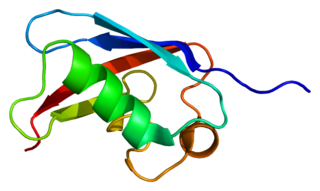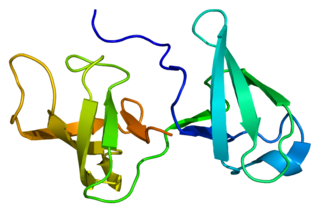
Lamina-associated polypeptide 2 (LAP2), isoforms beta/gamma is a protein that in humans is encoded by the TMPO gene. LAP2 is an inner nuclear membrane (INM) protein.

DNA replication licensing factor MCM2 is a protein that in humans is encoded by the MCM2 gene.

Nuclear respiratory factor 1, also known as Nrf1, Nrf-1, NRF1 and NRF-1, encodes a protein that homodimerizes and functions as a transcription factor which activates the expression of some key metabolic genes regulating cellular growth and nuclear genes required for respiration, heme biosynthesis, and mitochondrial DNA transcription and replication. The protein has also been associated with the regulation of neurite outgrowth. Alternate transcriptional splice variants, which encode the same protein, have been characterized. Additional variants encoding different protein isoforms have been described but they have not been fully characterized. Confusion has occurred in bibliographic databases due to the shared symbol of NRF1 for this gene and for "nuclear factor -like 1" which has an official symbol of NFE2L1.

Ras-related C3 botulinum toxin substrate 3 (Rac3) is a G protein that in humans is encoded by the RAC3 gene. It is an important component of intracellular signalling pathways. Rac3 is a member of the Rac subfamily of the Rho family of small G proteins. Members of this superfamily appear to regulate a diverse array of cellular events, including the control of cell growth, cytoskeletal reorganization, and the activation of protein kinases.

Barrier-to-autointegration factor is a protein that in humans is encoded by the BANF1 gene. It is a member of the barrier-to-autointegration factor family of proteins.

Translin is a DNA-binding protein that in humans is encoded by the TSN gene. Together with translin-associated factor X, translin forms the component 3 of promoter of RISC (C3PO) complex which facilitates endonucleolytic cleavage of the passenger strand during microRNA loading into the RNA-induced silencing complex (RISC).

FAS-associated factor 1 is a protein that in humans is encoded by the FAF1 gene.

Zinc finger protein RFP is a protein that in humans is encoded by the TRIM27 gene.

TRAF-interacting protein is a protein that in humans is encoded by the TRAIP gene.

DNA-binding protein A is a protein that in humans is encoded by the CSDA gene.

TRIO and F-actin-binding protein is a protein that in humans is encoded by the TRIOBP gene.

DNA/RNA-binding protein KIN17 is a protein that in humans is encoded by the KIN gene.

Fas-activated serine/threonine kinase is an enzyme that in humans is encoded by the FASTK gene.

Protein unc-84 homolog A is a protein that in humans is encoded by the UNC84A gene.

Translin-associated protein X is a protein that in humans is encoded by the TSNAX gene.

Bcl-2-associated transcription factor 1 is a Bcl-2 family protein in humans that is encoded by the BCLAF1 gene.

Zinc finger protein 346 is a protein that in humans is encoded by the ZNF346 gene.

Zinc finger protein 239 is a protein that in humans is encoded by the ZNF239 gene.

Coronin, actin binding protein, 2A is a protein that in humans is encoded by the CORO2A gene.

PBX/Knotted 1 Homeobox 2 (PKNOX2) protein belongs to the three amino acid loop extension (TALE) class of homeodomain proteins, and is encoded by PKNOX2 gene in humans. The protein regulates the transcription of other genes and affects anatomical development.



















